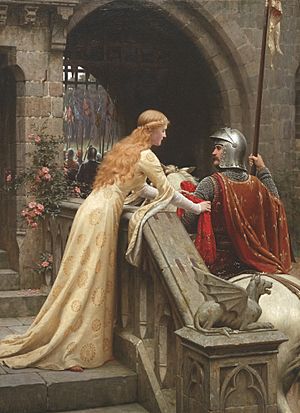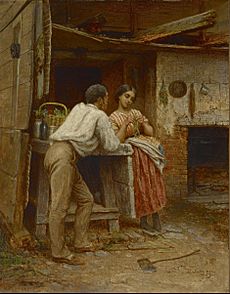Courtship facts for kids
Courtship is a special time when two people get to know each other. They do this before deciding if they want to get married or be in a serious, long-term relationship. Sometimes, courtship starts after a couple is already engaged and ends when they get married. It can be a private thing between just two people, or it can be more public, sometimes even arranged by families. Long ago, it was often the man's job to "court" or "woo" the woman. This meant he would try to get to know her and see if she wanted to marry him.
Courtship, as we know it today, is a fairly new idea. It has only become common in the last few hundred years.
How Courtship Changed Over Time
In the past, most marriages were arranged by parents or older family members. The main goal was not love. Instead, it was about making families stronger, gaining money, or forming important connections. Because of this, there wasn't much need for a special "getting to know you" time like courtship. A marriage was usually a business deal between families.
Around the 1700s, a big change started happening around the world. People began to believe more in the importance of each person's freedom. This led to more equality for everyone, including women. In the early 1900s, women slowly started to gain the right to vote. Norway was one of the first countries where women could vote in 1913. Women also gained the right to own property and be treated fairly by the law.
These changes greatly affected how men and women related to each other. Parents had less control over who their children married. In many places, people could decide for themselves if, when, and whom they would marry. However, courtship still looks different in various countries. It depends on local customs, religious beliefs, and social groups. Some countries still have arranged marriages, and some traditions are still very strong.
Different Ways People Court
In many cultures influenced by Europe, courtship is quite relaxed. But in some traditional societies, it follows very specific rules.
In some places, parents or the community suggest possible partners. Then, the couple is allowed a short time to get to know each other. This helps them decide if they are a good match. For example, in Japan, there is a practice called Omiai. A similar custom is called "Xiangqin" (相親) in China. Parents might hire a matchmaker. This person provides pictures and information about potential partners. If the young man and woman agree, they have a formal meeting. The matchmaker and often the parents are there. After a few meetings, the matchmaker and parents might encourage the couple to decide if they want to marry.
In more closed societies, arranged marriages are still common. In these cases, parents usually choose partners for their children. This means there is very little or no courtship at all.
Throughout history, courtship has included traditions like exchanging valentines or writing letters. The postal service, which became popular in the 1800s, made sending letters much easier. In recent years, the idea of arranged marriage has also changed. Sometimes, it mixes with other forms of courtship. This allows potential couples to meet and spend time together before making a decision about their relationship.
See also
 In Spanish: Cortejo para niños
In Spanish: Cortejo para niños



